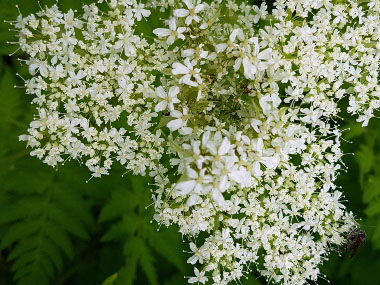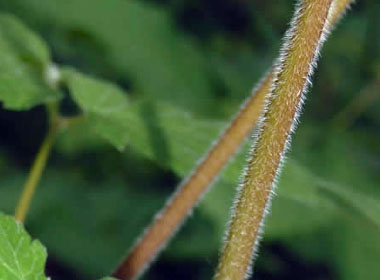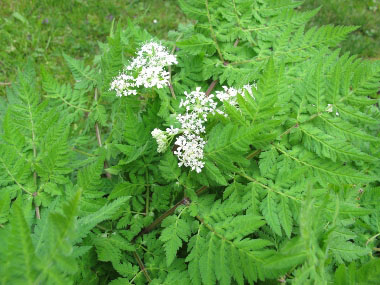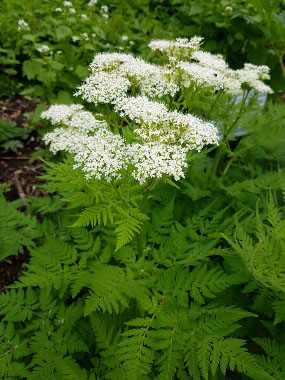






To support our efforts please browse our store (books with health benefits, etc.).
IMPORTANT: There are similar plants that are poisonous. Some of these include Poison Hemlock, Water Hemlock, Fool's Parsley and others. However, the poisonous members of this family lack the anise scent.
Aniseroot is native to North America and has a very close edible look-a-like, Sweet Cicely, which is native to Europe. The genus name, Osmorhiza, is derived from two Greek words, osme, meaning 'fragrance' and rhiza meaning 'root'. The species name longistylis is from the Greek root longus, meaning 'long' and with stylis referring to the longer style of this plant. This plant has thick, branching tap roots that terminate in long fibrous roots. Aniseroot is in the Apiaceae (carrot) family. The Chippewa and the Ojibwa chewed the root to relieve a sore throat. According to the Meskwaki in Wisconsin, this plant is "a good medicine for everything". Aniseroot is also a favorite food for livestock, and the roots are used by several tribes to entice or reward horses. Colonists adopted this plant as folk medicine to help with coughs. The aromatic scent of the roots was also considered to be an aphrodisiac. Aniseroot is an ophthalmic, carminative, stomachic and an expectorant.
Distinguishing Features
Aniseroot can be easily mistaken for Sweet Cicely (Osmorhiza claytonii). Sweet Cicely has fewer flowers per umbellet (4 to 7), and the stems are densely covered in long, spreading hairs up into the flower clusters. The hairy stems are the most noticeable difference. The leaves on both species are fern-like.
Flowers
The inflorescence is a tall stem topped by a compound umbel. The umbel typically has 5 umbellets. These umbellets have 8 to 16 flowers each with several lance-shaped, green, hairy bracts at the base. Bracts are also at the base of the main umbel. The white flowers are small, have 5 petals with notched tips. One or two of these petals will usually be longer than the others and the margins of the petals will have a slight fold. There are also 5 stamens with white filaments and white anthers that alternate with the petals. There is also a white style with two spreading stigmas, the style is as long or slightly longer than the petals. Anthers turn darker after pollen maturity. The flowers bloom in quick sequence from the outside toward the center of umbellets. Aniseroot blooms mid-spring to mid-summer depending on geographic location.
 Fields
of Nutrition has medicinal benefits and vitamin/mineral content of Aniseroot.
Fields
of Nutrition has medicinal benefits and vitamin/mineral content of Aniseroot.
Leaves
Leaves grow alternate and are divided into three principal sections (ternately compound). Leaflets have thin, rather flimsy blades with prominent irregularly wavy margins. The leaflets are up to 10cm (4") long and 5cm (2") wide, shallowly to deeply lobed with toothed edges, becoming smaller and less lobed as they ascend the stem. They are a dull light to medium green on the upper and lower surfaces. Leaf petioles are rounded on the upper side and flattened and grooved beneath. The compound leaves grow to 23cm (9") long and 30cm (12") wide.
Height
This herbaceous perennial plant grows about 30 to 75cm (1 to 2 1/2') tall, branching occasionally. The stems are light green to reddish purple, cylindrical or slightly tapering, and they may be smooth, with some hair or densely covered with straight fine hairs.
Habitat
Aniseroot grows east of the Rockies to the Atlantic and as far north as Hudson Bay. It prefers rich, often alluvial soils. It tends to grow along the sides of streams and in dappled sunlight or moderately shaded areas. It does not tolerate intense ground disturbances.
Edible Parts
Raw leaves can be used as an aromatic additive to salads though they have a somewhat bitter aftertaste. Young shoots can also be consumed. Leaves and roots have a licorice or anise-like flavor. Roots can be used raw or cooked. They are sweet, fleshy and are pleasantly aromatic. Roots can be chewed or made into a tea. The green seeds also have an anise flavor and can be used in salads. Always be sure of the identification before using!
Other Name
Sweet Anise.
Similar Plants
Hemlocks.
Winter Survival Food Handbook

PDF Plant Magazines
Types of Wild Food
Geographic Zones Seasons
Disclaimer
EdibleWildFood.com is informational in nature. While we strive to be 100% accurate, it is solely up to the reader to ensure proper plant identification. Some wild plants are poisonous or can have serious adverse health effects.
We are not health professionals, medical doctors, nor are we nutritionists. It is up to the reader to verify nutritional information and health benefits with qualified professionals for all edible plants listed in this web site. Please click here for more information.
Why Edible Wild Food?
- Food costs are rising
- Free, wild food is readily abundant
- Wild food adds nutrition to your diet
- Wild food can help treat various medical conditions





